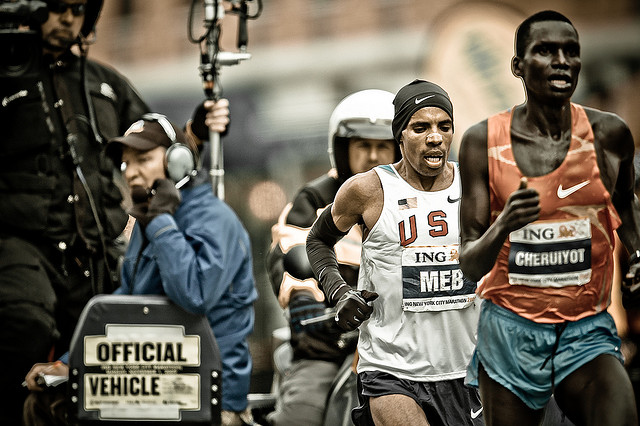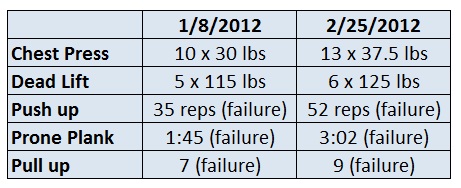Ever wish you could be stronger – while weighing less?

It’s the ideal scenario for distance runners: massive strength without any extra weight.
During the last seven weeks, I tried to improve both. I had been lifting regularly, but my routine was the same it had been for months and my performance had plateaued.
My strength program needed a complete overhaul; I had been doing the same few exercises in the same circuit:
- dead lifts
- chest press
- pull ups
- pistol squats
- dips
I was going to the gym and rushing out after two sets and only 15 minutes because honestly, I don’t like lifting. There’s a lot of waiting around. I’d rather run for an hour than spend 30 minutes in the gym. It’s how I’m wired.
But weights are important – they can help prevent injuries, improve your finishing kick, and make you more efficient. Skipping the gym is like skipping a long run or tempo run – they’re all important ingredients in a sound training plan.
Lifting to Failure, Variety, and More Rest
I decided to follow a lifting program from the Rebel Strength Guide, designed by Steve Kamb of Nerd Fitness (note: this program is no longer available. If you’re interested in runner-specific strength work, see this program instead which I also use). At first I was hesitant because I didn’t want to gain muscle mass – just strength.
But then I realized there’s no way I can gain muscle weight. It’s a common misconception (especially among women) that lifting heavy will result in “bulk” or “mass.” For the most part, it’s nonsense. There’s a few reasons why it won’t happen:
- If you’re doing any decent amount of running or cardio exercise, it’s extremely difficult to gain muscle mass. Too much of your protein is used for recovery instead of hypertrophy.
- Women have much less testosterone than men, so putting on “bulk” is nearly impossible for average people. Just look at Staci (and she dead lifts well over 300 pounds!).
- To really put on muscle, your focus has to be on eating an enormous number of calories. If you eat normally, you won’t have enough fuel to gain weight.
The exercises I did from the Rebel Strength Guide are all functional, multi-joint exercises that train movements, not muscles. I believe in compound exercises for runners – no bicep curls, hamstring extensions, or calf raises. Unless I’m treating a specific imbalance (like with my ITB Rehab Routine), I don’t do isolation exercises.
Here’s what I did during my 7 weeks of the program:
- Lunges
- Push Press
- Planks
- Side Planks
- Front Squats
- Dead lifts
- Pull ups
- Bent over rows
- Push ups
More importantly than the specific exercises I did, was how I did them. This is the most important part of the Rebel Strength Guide. My normal routine had me going through my gym exercises in a circuit with no rest. This is how I was able to get everything done in 15 minutes (I hate lifting, remember?).
But RSG does things differently: you prioritize performance over time and most of the exercises are done to failure – meaning you can’t do one more rep. You take a full 1-2 minutes of rest in between each set. The workout takes a little while longer, but you see bigger strength gains.
There’s also a warm-up to the lifting routine, something I’ve never done before. Ironically, I preach on and on about the benefits of a running warm-up but never did one before my gym workouts. With a good warm-up, I felt better prepared to lift and will definitely continue doing one. It’s a no-brainer.
How to Improve Your Lifting Routine
If you already spend a few hours in the gym every week and know what you’re doing, the Rebel Strength Guide probably isn’t for you. But if you’re new to strength exercises or if you’re like me and just do the same routine over and over again because you don’t really like the gym, then it could be helpful.
I loved the video examples of every exercise and I’d watch them as I was doing the workout (I chose the “Dumbbell Division” so I could do many of the exercises at home – there are also body weight and barbell progressions). I wanted to make sure my form was correct so the videos were really helpful.
Runners will need to amend the advice and workouts slightly if they follow along. First, the diet section leans heavily on the paleo diet, which is fine if you’re not running a lot. But if you are putting in any amount of good training, you’ll need some carbs to refuel.
Here are my notes from my month with the Rebel Strength Guide on how to adjust the workouts for runners:
- Never do these workouts before you run, they’re far too difficult.
- Take advantage of the full rest in between sets. It will feel like way too long at the beginning but too short by the end.
- Distance runners are used to giving a max intensity over a long period of time – like a race – which is far different than a max effort with weights. Think more like a sprinter; lifting to failure is to FAILURE not just high fatigue.
- Don’t do these workouts after a long run or hard workout. They require a high amount of energy – instead, do them after an easy run or on your day off from running.
- Don’t start this program if you haven’t been lifting at all. The sets to failure will destroy your muscles and you’ll be sore for weeks. Get in good baseline shape with a simple gym routine first so it’s not a complete shock to your body.
- If you feel destroyed after one or two sets to failure, it’s okay to skip the last set. You don’t want to be so sore and fatigued that you can’t get back into the gym in a few days. Remember, it’s more important to be consistent and keep progressing than to dig your fitness in a hole by trying to do too much.
- I replaced the RSG warm-up with a modified version of the ITB Rehab Routine and some push ups. This is my personal weakness so I knew it was something I needed to work on.
- You can cut sets or reps if you need it, but you can also add reps if you think something is too easy. In one workout, I had to do 3 sets of 8 lunges. I usually do 50 lunges (in 5 different planes of motion) in a row before every run, so this part of the workout was incredibly easy. I modified this to 30 lunges in a row in 5 planes of motion (6 for every type of lunge).
- Prone planks will be FAR easier for runner than side planks. I had trouble doing multiple sets of side planks, but sailed through (relatively speaking) the prone planks. This weakness is typical for runners and means we have to work on our side planks.
- If you’re training hard for a race – especially a long one like a marathon – then you shouldn’t focus on lifting. Your priority needs to be running.
The workouts will take you about 30 minutes each – short, but they’re all tough! Lifting to failure is something I rarely do and I was struggling…exactly what I was looking for in a weight program.
I chose to do the three workouts per week program, but there’s a four-day schedule for more ambitious folks who may not be running 60+ miles per week like I was.
So how’d I do? Let’s take a look.

My weight was 130.0 pounds at the beginning of the experiment and 126.0 at the end – a 3% loss. I weighed myself at the same time of day for each weigh-in (in the morning before my run) and used the average of three times on the scale. The interesting thing about my weight loss is that I didn’t change my diet whatsoever during these seven weeks. I ate relatively healthy with some occasional indulgences – the only thing that changed was my lifting program and running about 10-15 more miles per week.
Even with my weight decreasing by four pounds over the month, I saw significant increases in strength across the board. While I don’t really care about upper body strength (I’m a runner and already married), it’s nice to see that I can bang out a decent set of pull ups or push ups. Based on the push up, pull up, and plank tests I improved by an average of 50% – pretty damn good!
I learned a valuable lesson during my time with the Rebel Strength Guide program: intensity matters in the gym if you want to see real strength gains. You won’t get stronger by lifting light or moderate for high repetitions. Instead, go heavy. Coincidentally it’s more effective for runners.
You train for endurance when you run. You train for strength in the gym.
Even though this program isn’t available anymore, if you’re in a rut with your strength work you might enjoy the Strength Training for Runners program. It’s a new way to structure your strength sessions and will help you prevent more injuries too!